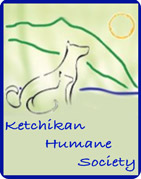|

Sunday
July 18, 2021
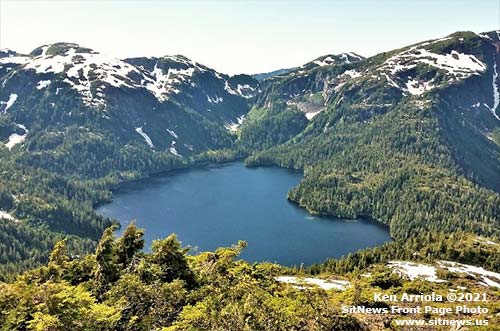
Silvis Lake
Twin Peaks summer view of Upper Silvis Lake, looking northward at Northbird and Mahoney mountains.
SitNews Front Page Photo By KEN ARRIOLA ©2021
To have your photo(s) featured on the front page,
email your photo(s) to editor@sitnews.us
|
|
Southeast Alaska: Are the Tongass Timber Wars Finally Over? Biden Administration Moves to Protect Roadless Areas in Tongass National Forest Posted & Edited By MARY KAUFFMAN - The U.S. Department of Agriculture (USDA) announced last week (July 15, 2021)a new Southeast Alaska Sustainability Strategy to help support a diverse economy, enhance community resilience, and conserve natural resources. Through this strategy, USDA says it will consult with Tribes and Alaska Native corporations, and engage partners and communities in a collaborative process to invest approximately $25 million in financial and technical resources in sustainable opportunities for economic growth and community well-being and identify priorities for future investments.
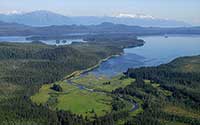
King Salmon River delta on Northern Admiralty Island.
Photo by John Schoen |
Last week's announcement is said by the USDA to be in line with the Biden-Harris Administration’s approach to climate-smart forest management and conservation nationally, recognizing the importance of advancing the pace and scale of restoration and reforestation, addressing the challenge of wildfire, and retaining climate-resilient forests that provide ecologic, social and economic benefits and support rural community well-being.
This move by the Biden administration will rollback a Trump-era rule that exempted the Tongass from the national Roadless Rule. The Biden administration made an announcement about a month ago that promised to “repeal or replace ” the Trump administration rule.
The Tongass spans nearly 16.7 million acres, covering nearly all of Southeast Alaska, and is home to 32 islanded communities. For decades, successive layers of federal law and regulation, including the 2001 Roadless Rule, have continually restricted access needed for timber, mining, tourism, recreation, and the development of renewable resources, such as hydropower and necessary transmission lines.
As a key part of Southeast Alaska Sustainability Strategy, USDA will end large-scale old growth timber sales on the Tongass National Forest and will instead focus management resources to support forest restoration, recreation and resilience, including for climate, wildlife habit and watershed improvement. Small and micro old growth sales will still be offered for community consumption and cultural uses such as totem poles, canoes and tribal artisan use. USDA will also initiate a rulemaking this summer that will propose to restore 2001 Roadless Rule protections on the Tongass National Forest, returning stability and certainty to the conservation of 9.3 million acres of the world’s largest temperate old growth rainforest.
Secretary Tom Vilsack has directed leaders of multiple USDA agencies, including the Forest Service, the Natural Resources Conservation Service, and Rural Development, to consult with Tribes and work together with partners and communities in Southeast Alaska to identify priorities for investment that reflect the diverse needs and opportunities in the region, including for recreation, fisheries and the fishing industry, mariculture, renewable energy, sustainable timber management including for young growth, traditional and customary cultural uses, and carbon sequestration.
“We look forward to meaningful consultation with Tribal governments and Alaska Native corporations, and engaging with local communities, partners, and the State to prioritize management and investments in the region that reflect a holistic approach to the diverse values present in the region,” said Secretary Vilsack. “This approach will help us chart the path to long-term economic opportunities that are sustainable and reflect Southeast Alaska’s rich cultural heritage and magnificent natural resources.”
According to Alaska Governor Michael Dunlevy (R-AK), President Joe Biden’s efforts to put Alaska workers permanently into unemployment lines and wipe out small businesses continues with the United States Department of Agriculture’s announcement restarting efforts to shut down Southeast Alaska with the roadless rule.
Alaska Governor Dunleavy commented on what he calls "Biden's America and Alaska Last" approach. Quoting a news release from the governor's office, President Joe Biden’s efforts to put Alaska workers permanently into unemployment lines and wipe out small businesses continues with the United States Department of Agriculture’s announcement restarting efforts to shut down Southeast Alaska with the roadless rule.
“The Forest Service has already conducted a thorough analysis and determined that an Alaska-specific exemption from a one-size-fits-all roadless rule was fully justified,” said Governor Mike Dunleavy. “Narrow election results and political donations from environmental groups do not justify this federal agency’s policy flip-flop.”
Governor Dunleavy continued saying, “Much like XL Pipeline workers and others, American and Alaskan families just want the chance to work and support their families. Our state’s southeast communities need fundamental access, like roads, and the economic and resource development opportunities roads provide. Every Alaskan deserves the chance to work. We have the resources. We just need the opportunity.”
Dunleavy said, “Let me be clear, where the State of Alaska can partner with the federal government on efforts that make the lives of Alaskans better, Washington D.C. will not find a more willing partner. But where there will be disagreement, my administration will make the feeling of this state known.”
“Sustainable forest stewardship both protects the ecological values of our forests and supports local economies by providing stable, good-paying jobs,” said Alaska Department of Natural Resources Commissioner Corri Feige. “The Tongass was created to serve multiple uses, including a sustainable timber industry. Arbitrary reimposition of a roadless rule will deprive Southeast Alaska communities of a diversified economy that includes working forests as well as tourism and fishing.”
U.S. Senators Lisa Murkowski and Dan Sullivan, and Congressman Don Young (all R-Alaska) issued the statements after the Biden administration announced it will seek to revoke the Tongass National Forest’s full exemption from the 2001 Roadless Area Conservation Rule (Roadless Rule), granted under the previous administration, and also further diminish the supply available for a viable timber industry. This announcement is part of Southeast Alaska Sustainability Strategy, which included approximately $25 million in federal investments for the region. - More...
Sunday PM - July 18, 2021
|
|
Ketchikan Historical: The Death of a Snitch; Who or what killed Tiny Walker In Ketchikan's Prohibition Days? By DAVE KIFFER
- Ketchikan sometimes glamourizes the local scene during Prohibition. While the rest of the country was allegedly "bone dry" from 1919 to 1933, Ketchikan's booming salmon canning economy and its proximity to ready alcohol in Prince Rupert meant that the First City was anything but "tee-totaling" despite the best efforts of the territorial prohibition agents.
While almost every edition of the Ketchikan Chronicle in those days had a story about an arrest for violations of either the Volstead Act or the Alaska Bone Dry Law, in truth Ketchikan was as "wet" in the 1920s at it was in the 1980s when there were more than 50 legally operating liquor licenses.
It seems like every long-time family has a tale about relatives who were "rum rummers" in the 1920s. And stories about places like Buggie Beach, Charcoal Point, Ward Cove and Whiskey Cove being awash with shipments of "firewater" arriving from Canada. Plus, it seemed like just about every remote cabin in the area had "stills" or home brew operations. If you know where to look on the back side of Pennock or the southend of Gravina, you can still find the rusty remains of the stills that helped supply Ketchikan nearly a century ago.
Even today,, we gleefully point out the trap doors in the old buildings Downtown where skiffs came up at high tide and unloaded their illicit cargo into the bawdy houses and afterhours clubs.
But violating the anti-alcohol laws was a crime and there were indeed some real criminals involved. One of those was a man who made his way up from Seattle in the early 1920s. His real name was David I. Chess.
Almost no one in Ketchikan called him David. He was better known by his AKA, Tiny Walker. Chess, a very big man, had been a professional wrestler in Seattle and Portland. His stage name was Tiny Walker. The Tiny was intended to be ironic.
By 1929, he was a fixture in the local illegal alcohol scene. He ran with a very dangerous crowd, including the infamous Matt Berkovich. Berkovich would show just how dangerous when he murdered an informant in broad daylight a year later. (See "Black Matt Berkovich: A Ketchikan Story, SITNEWS, Aug. 19, 2015)
Tiny Walker died suddenly on June 27, 1929, shortly after helping revenue officers intercept a load of booze.
"David I. Chess, better known as Tiny Walker, died from unknown causes on the F.I.P cannery dock last night, less than an hour after he had given two federal officers information which resulted in their seizing a liquor laden car," the Ketchikan Chronicle reported on June 28. "His body showed no marks of external violence, it was announced by Dr. J. Beeson."
The paper reported that Chess' body was discovered by cannery watchman Ole Johnson "lying on the board roadway leading to the canner, about 30 feet off Stedman Street. His body was against the fence. A revolver was found in his pocket."
"With Chess' death, it was revealed by Fred Handy, prohibition officer, that the former wrestler and convicted bootlegger had been furnishing undercover information concerning liquor shipments for four weeks," the newspaper reported. "On the strength of information brought to them by Chess shortly after midnight, Handy and C. J. Sullivan, deputy marshal, seized a car containing three sacks of moonshine liquor at the street corner by the Ketchikan cold storage. The driver of the car escaped. A second car which the officers asserted also contained liquor, escaped by backing up at high speed to the city float, where it turned and sped away. Sullivan fired one shot in an effort to stop it, the seized car is registered under the name of Dell Stickler."
Handy told the Chronicle that Walker had been giving authorities inside information after he said his cohorts framed him, leading to his arrest. - More...
Sunday PM - July 18, 2021
|

Matthew Bzdega, MD, named Chief Medical Officer for PeaceHealth Ketchikan Medical Center |
Ketchikan: Matthew Bzdega, MD, named Chief Medical Officer for PeaceHealth Ketchikan Medical Center - Sudhakar Karlapudi, MD, PeaceHealth Northwest Network Chief Medical Officer, and Dori Stevens, PeaceHealth Ketchikan Chief Administrative Officer, announced the appointment of Matthew Bzdega, MD, as the chief medical officer (CMO) for PeaceHealth Ketchikan Medical Center. Dr. Bzdega is an anesthesiologist and serves as chief of the department of anesthesia. His familiarity with Ketchikan and demonstrated leadership skills make him well-suited for this part-time CMO position.
In his role as CMO, Dr. Bzdega serves as a member of the local executive team working closely with medical center leaders and medical staff. He is responsible for ensuring clinical quality across the medical team and through medical staff operations to create and support a patient-centered environment.
Dr. Bzdega sees his role largely as patient advocacy, prioritizing the issues most important to our local patient population. He looks forward to bringing the knowledge physicians have about treating their patients to the leadership table to support making patient-centered decisions. - More...
Sunday PM - July 18, 2021
|
|
Alaska: Alaska Sues Biden Administration for Breaking Promises on Federal Land Orders - On the 63rd anniversary of the signing of the Alaska Statehood Act [07/07/21], Governor Mike Dunleavy announced that the State of Alaska is suing the U.S. Department of the Interior for illegally and unjustifiably extending decades-long restrictions on nearly 28 million acres of federal land in Alaska. The action by Secretary Haaland blocks State land selections and Alaska Native Vietnam Veteran allotments.
“This is a methodical effort by the Biden administration – more than just bureaucratic foot dragging – to frustrate ANILCA and the Statehood land entitlement and leave these lands locked up as de facto parks,” said Governor Dunleavy. “They are consciously ignoring and going around appropriate processes to hold things in perpetual limbo. It has needed to be challenged for a long time and it needs to be challenged now more than ever due to these new delays – and I am challenging it. The intent of ANILCA matters, these unnecessary withdrawals need to be lifted, and we need to finally move this process forward. This is another federal attempt to deny Alaska the full realization as a State promised under our Statehood Compact, and it should not stand.”
Quoting a news release from the governor's office, these withdrawals have prevented the State from exercising its Statehood right to claim valuable lands or assess the natural resources on these lands, and blocked Alaska Native Vietnam War veterans from selecting land allotments.
Under a 1971 federal law, the Secretary was allowed to issue temporary land withdrawals to restrict the use of federal land in Alaska to allow the Department of Interior time to determine how federal lands should be used in the state. These withdrawals also effectively prevented the transfer of temporarily withdrawn lands to the State under the Alaska Statehood Act. Many of these 1970s-era orders have never been lifted even though the reasons for the withdrawals have been satisfied for decades. Under 16 such orders, about 28 million acres of land have sat under outdated restrictions, all the while with the federal government proposing that the withdrawals be lifted but never doing so.
In 2006, the Bureau of Land Management reported to Congress that these temporary withdrawals could be lifted on over nearly all these areas without affecting the public interest. Following that report, BLM has completed numerous, multi-year reviews and land-use plans, each recommending that the withdrawals be lifted. In January of this year, then-Interior Secretary David Bernhardt issued orders based on these extensive analyses to finally lift these 16 land withdrawals from about 28 million acres.
Shortly after assuming office, however, President Biden’s new Interior Secretary, Deb Haaland, announced she was unilaterally repealing Secretary Bernhardt’s actions from taking affect for at least two years, claiming that the Department needed to conduct even more analyses of environmental, endangered species, historical preservation, and military land use laws – analyses that the BLM, itself, said it had already completed or were unnecessary. - More...
Sunday PM - July 18, 2021
|
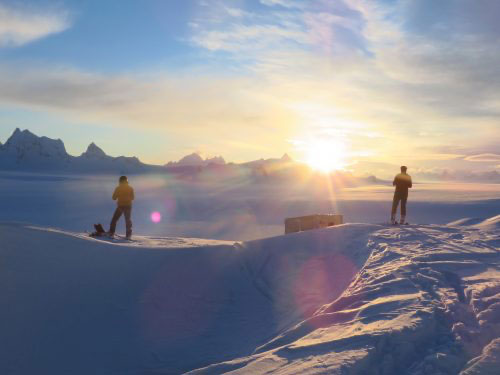
Runoff from melting Juneau Icefield increases
By MOLLY TANKERSLEY
Runoff from melting Juneau Icefield increases By MOLLY TANKERSLEY
Researchers travel by ski to remote locations on the Juneau Icefield to collect snow and melt measurements in April 2015.
Photo courtesy of Joanna Young |
|
Southeast Alaska: Runoff from melting Juneau Icefield increases By MOLLY TANKERSLEY - Glacier runoff from one of the largest icefields in North America has been increasing for more than three decades, researchers from the Alaska Climate Adaptation Science Center at the University of Alaska Fairbanks have found.
As the Juneau Icefield continues to lose mass, the flow will increase until “peak runoff” is reached, the researchers predicted.
Peak glacial melt each season is also arriving earlier than in previous decades, altering stream habitat and hydrologic patterns in the surrounding watersheds and downstream estuaries. Area streams and rivers now see higher total runoff in the spring, with increases annually as well.
Prior to this study, which was published in the journal Water Resources Research, glaciers’ contribution to these coastal rivers was unknown. Moreover, Southeast Alaska is an extremely wet environment, with highly variable precipitation patterns that make it difficult to distinguish trends in the sources of streamflow captured by stream gauges.
“Precipitation is such an overwhelming signal in the area, both in terms of sheer quantity and variability through different times of the year and through different years. It wasn’t clear if we would even be able to see the change in glacial input to streams amid the chaos of normal precipitation in Southeast Alaska,” said lead author Joanna Young, an AK CASC postdoctoral fellow.
The team used a model that combines glacial, riverine and soil moisture processes. That allowed them to determine if increases in water volume are driven by snowmelt, heavy precipitation or glacial runoff.
The model data produced by Young and her colleagues show that annual glacier ice melt on the Juneau Icefield has increased since the 1980s by 10% per decade and glacier runoff by 3%. (Glacier runoff includes water from both glacier ice melt and precipitation flowing off the glacier, so the increased percentages of ice melt and runoff differ.) Total runoff in the study’s watersheds increased by 1.4%. Peak runoff from glacial melt every year is occurring 2.5 days earlier each decade now than in the 1980s. - More...
Sunday PM - July 18, 2021
|
|
Fish Factor: Early snapshot of average base prices from major fish processors By LAINE WELCH - Early prices to Alaska salmon fishermen are trickling in and as anticipated, they are up across the board. That will give a nice boost to the economic base of both fishing communities and the state from fish taxes, fees and other assessments.
About one-third (62 million) of Alaska’s projected catch of 190 million salmon had crossed the docks by July 16 at the half-way point of the fishing season.
Prices paid to fishermen vary based on buyers, gear types and regions, and bonuses and post season pay adjustments won’t be finalized until early next year.
Here’s an early snapshot of average base prices from major processors at this point in the season:
At Bristol Bay, the price to fishermen was boosted to $1.25 by OBI Seafoods, topping the $1.10 Peter Pan posted in June before the start of the fishery, and up from $0.70 last year.
Kodiak fishermen were getting $1.45-$1.50 for sockeyes and $1.75 at Southeast.
That compares to a statewide average of just $0.76 a pound for sockeye salmon last year. A 2021 catch of 46.6 million sockeyes is expected for Alaska; the total so far has topped 44 million.
Pink salmon were averaging $0.35 cents a pound for fishermen. An Alaska harvest of 124.2 million pinks is expected this summer, nearly 49% higher than last year. The statewide pink salmon price in 2020 averaged $0.30 cents a pound.
Chums were averaging $0.50 per pound for Kodiak fishermen, twice last year’s price, and $0.85 at Southeast Alaska, compared to $0.45. The average chum price in 2020 was $0.43 cents a pound.
According to the Alaska Dept. of Fish and Game, troll-caught kings at Southeast were averaging $6.73 a pound, compared to a statewide average of $5.07 last year. With average weights at 11 pounds, each Chinook was again worth more than one barrel of Alaska crude oil. ($74.03 vs.73.48 as of July 16).
Coho salmon catches will begin adding up in August but troll caught silvers at Southeast were paying fishermen a whopping $2.50 per pound for all sizes. That compares to $1.74 at the Panhandle last year and a statewide average for silvers at $1.17.
Smaller sockeyes:
The run of sockeye salmon returning home to Bristol Bay could set a record at 66 million fish. The Bay-wide catch has topped 36 million, but the reds are smaller than in past years.
The average size this summer is 4.5 pounds compared to 5.1 pounds last year, said Dan Lesh with McKinley Research Group. Still, the sockeyes are heading into an eager market.
“Supply is low and there is strong demand for premium seafoods across the board,” he said. “People have more money and spending at foodservice is at pre-pandemic levels.”
It’s “so far, so good” as far as putting a smaller fish on the plate, Lesh said, adding that it could mean adjustments for various salmon products.
Bristol Bay reds aren’t the only ones shrinking.
Chinook size has declined the most at 8%; 3.3% in cohos, 2.4% in chum salmon and a 2.1% shrinkage in sockeyes overall.
That’s based on 60 years of measurements from 12.5 million Alaska salmon, excluding pinks by Nature Communications that compared average body lengths before 1990 and after 2010. - More...
Sunday PM - July 18, 2021 |
Money Matters: HOW DO THE MEGA RICH AVOID PAYING INCOME TAX? By MARY LYNNE DAHL , Certified Financial Planner ™
- According to a media buzz going around currently (June 2021), some of the world’s richest people pay no income taxes. Is this true? Well, maybe it is, but maybe it isn’t. It may just be how the media, especially the notoriously wrong social media, sells readers on whatever “news” they are peddling. It may be entirely false, but it sure sells.
More importantly, however, is the question of whether or not it is actually possible that someone who is a billionaire can avoid income tax. Is this possible? The answer is yes, it is certainly possible. It is usually, probably in fact almost certainly, that it is the result of very careful planning by the mega rich. How can they do this, considering how rich they are?
There are a number of legal ways to avoid income tax. The most obvious is to have no income. The mega rich own assets, but they may not earn a wage. Without wages and earned income, you do not pay an income tax. So, the careful plans they develop to avoid income tax could, for example, involve directing that all income from their assets go into a trust which pays for the expenses of the individual, rather than the individual paying for those expenses themselves. The trust would pay the tax, not the individual. The result would be that the individual, with no income, would pay no income tax. The trust could, however, pay as much or more tax than the individual would have paid, but that may not have been the primary goal in the first place. Often, assets are placed in a trust to protect those assets from other risks, but not taxes. So, if this is a strategy used by a very rich person, it only appears that s/he pays no income tax. Strictly speaking, it is true, but it it does not show the whole picture. - More...
Sunday PM - July 18, 2021
 |
CARL GOLDEN: FAUCI CAN DEFEAT THE VIRUS, BUT NOT CONSPIRACY THEORIES - About 34 million people have fallen ill with COVID-19 in the U.S. and nearly 610,000 have died. Protection is readily at hand, but is going to waste in storage and in some cases while millions refuse to avail themselves of it.
Americans, usually among the most responsive people on the globe when confronted by a widespread and out of control contagion, have resisted accepting a highly effective vaccine out of doubts about its safety. Some believe the pandemic is a false narrative, while other think government-sponsored inoculation is a violation of their constitutional right to privacy.
It is small wonder that Anthony Fauci, director of the U. S. National Institute of Allergy and Infectious Diseases, will likely appear in the Guinness Book of World Records for the most consecutive days of mind-bending frustration. - More...
Sunday PM - July 18, 2021
DANNY TYREE: HAVE YOU BEEN AVOIDING THE DENTIST? - Life is returning to normal. But where dental health is concerned, normal may not be good enough.
According to a report from the U.S. Centers for Disease Control and Prevention, even BEFORE the pandemic, one-third of American adults under 65 hadn’t had a dental exam or cleaning in more than a year.
That is a disturbing statistic. If Annie was correct in singing, “You’re never fully dressed without a smile,” an awful lot of us are going commando.
I’m not into floss-shaming, but I conscientiously kept my six-month checkup appointment earlier in July, and I hope I can convince a few of you to get back into the dentist’s chair. - More...
Sunday PM - July 18, 2021
|

Political Cartoon: Biden's Inflation
by Gary McCoy©2021, Shiloh, IL
Distributed to subscribers for publication for Cagle Cartoons, Inc.
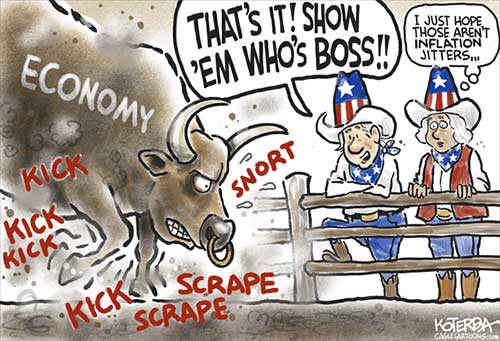
Political Cartoon: The Economy and Inflation
by Jeff Koterba ©2021, CagleCartoons.com
Distributed to subscribers for publication for Cagle Cartoons, Inc.

Political Cartoon: US Senate Bill To Decriminalize Marijuana
by R.J. Matson ©2021, CQ Roll Call
Distributed to subscribers for publication for Cagle Cartoons, Inc.
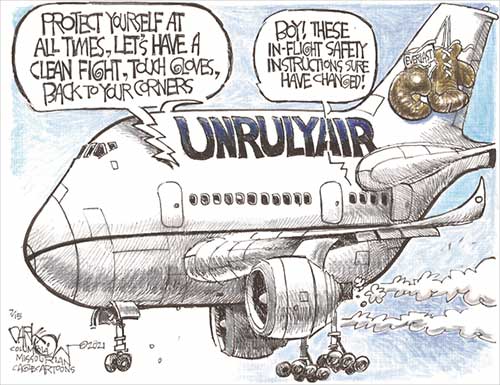
Political Cartoon: Unruly passengers
by John Darkow ©2021, Columbia Missourian
Distributed to subscribers for publication for Cagle Cartoons, Inc. |
Open Letter to Alaska State Legislators By Michael Goehring - I am writing today in response to your May 7 letter sent to the Honourable John Horgan, Premier of British Columbia, expressing your concerns about the potential impacts of abandoned, active, and future mines on shared waterways between BC and Alaska.
From the perspective of the Mining Association of British Columbia (MABC), it is important to underscore the shared responsibility British Columbia, Alaska, and natural resource industries on both sides of the border hold to ensure the highest standards of environmental protection and transboundary water quality are in place.
As neighbors, we have a shared interest in responsible resource development that effectively balances environmental stewardship and economic development. We share your concern with declining salmon populations on both sides of the border and we have a shared obligation and duty to consult, accommodate and engage in partnerships with Indigenous nations on natural resources and other matters.
I would like to clarify for you the status and nature of the regulatory framework that governs British Columbia’s mining industry. Contrary to assertions in recent media reports that referenced your letter to Premier Horgan, British Columbia’s mining industry meets among the highest regulatory standards in the world for environmental assessment, operational permitting, compliance and enforcement, and post-closure monitoring and reclamation.
Over the past five years, the Government of British Columbia has made substantial changes to the regulatory regime governing mining. This includes changes to the Mines Act, the Health, Safety and Reclamation Code for Mines, BC’s water quality guidelines, and the creation of independent review boards for tailings management. - More...
Sunday PM - July 18, 2021
Sine Die By Rep. Dan Ortiz - On Monday June 28th, the Alaska House of Representative was able to come together for a final passage vote of the state budget, averting a looming government shutdown. The budget totals $4.5 billion in state unrestricted general funds, which is very similar to previous year budgets, continuing the six-year trend of flat spending.
The budget forward funds the Alaska Marine Highway System for 18 months, giving more stability for future season schedules. The budget also includes an additional $2.5 million for Pre-K programs, funds to reopen the Wrangell Fish & Game office, funds for DIPAC and Crystal Lake Hatcheries, and a slight increase over the Governor’s compact to the University.
Unique to this year, the budget includes one-time federal COVID-19 emergency funds that will be given directly to local communities, provide tourism relief, and offset other small business and nonprofit lost revenue. - More...
Sunday PM - July 11, 2021
Alaska's Budget By Senator Bill Wielechowski - The new fiscal year began on July 1st . With the Governor’s vetoes, the budget appropriates $4.3 billion in unrestricted general funds for state operating expenses and $240 million for the capital budget, which authorizes or leverages nearly $1.6 billion spending in federal funds for roads, bridges, parks, maintenance, and other important
The Governor’s Budget Vetoes
The Governor vetoed $889 million from the budget that passed the Legislature.
The Governor’s vetoes include: - More...
Sunday PM - July 11, 2021
Base Dividends on resource revenue deposits to the Fund, instead of percent of Fund earnings. By Ray Metcalfe - Almost daily, I read where some legislator is pontificating over what we meant back when we, in the 11th and 12th Legislature, were setting up the Permanent Fund's management and Permanent Fund Dividend program. But so far, not one Legislator has bothered to ask.
When I was in the 11th Legislature, I was a member of the House Committee that proposed and wrote the first proposal for a dividend; the proposal the US Supreme Court threw out because of excessive residency requirements.
In the 12th Legislature, I chaired the House Committee through which the second Dividend proposal passed. It was Jay Hammond's bill, the one that legislators are still arguing over what we meant.
I also chaired the House State Affairs Committee that worked with its Senate counterpart drafting the investment strategy for the Alaska Permanent Fund. Acting against the political pressures of the day, we made the Permanent Fund a growth fund. The oil companies, the Chamber of Commerce, and Common Wealth North all wanted to get their hands on it. Had they had their way, there would be no Fund and no Dividend today.
Back then, many of us wanting it to be a growth fund had hopes that the Permanent Fund would grow until its earnings exceeded oil revenues. At that time, we hoped voters would pass an additional constitutional amendment committing all future revenues from the sale of resources to the fund, and authorizing the Legislature to draw out a fixed percent each year thereby creating an endowment to guarantee a stable economy with dividends included. - More...
Sunday PM - July 11, 2021
Violation of our civil rights By Joe Bialek - It has been common knowledge for years that all major developing countries have possessed the ability to conduct germ warfare.
The Wuhan crisis is no exception. Was a virus created in the lab and deliberately leaked into the local wet markets for experimentation on the people of Wuhan? This is totally consistent with China's poor record on civil rights and it's complete lack of concern for all of the Chinese people.
The virus created in Wuhan is by no means a poor reflection on all Asians especially Asia-Americans. It is simply a reaffirmation of the Communist Chinese Government's inhuman disdain for human life. They are the ones to blame.
Now we the American people are required by our government to get the vaccine without being told what are the short/long term side effects. This is inherently a violation of our civil rights. - More...
Sunday PM - July 11, 2021
RE: Ward Cove has Been Ketchikan's Economic Engine for 100 years By Terri Sims - My great grandfather was Eugene Wacker and my great grandmother Lillian Wacker, his wife. My mother was raised by her grandparents (Wackers) in Ward Cove and many of the children in the school photo would be her aunts and uncles she was raised with. I will send the article with the picture of the house to my mother who is 81 and determine if the house was the Wacker home. I also have some postcards for Wacker city made by my grandfather which are definitely not considered appropriate today but nonetheless are history. - More...
Sunday PM - July 11, 2021
The United States Needs Allies By Donald Moskowitz -President Biden is working on reestablishing and nurturing our relationships with our allies in the world.
We are recommitting the United States to backing our European allies against the influence and territorial ambitions of Russia; and NATO is the key organization positioned to block Russian moves in Europe, and it is needed to help combat Russia's cyber attacks on our infrastructure.
In the Far East China is significantly expanding its military and reach in the South China Sea. Our support of Taiwan, The Philippines, and Japan is critical to containing China's ambitions in the region. As a counter weight to China, we should probably encourage Japan to embark on a limited build up of its military forces, especially its Navy and missile capabilities. Additionally, we have to counter China's pilfering of our intellectual property. South Korea needs ongoing support to deter North Korean threats. - More...
Sunday PM - July 11, 2021
Email letters, opinions, OPEDs to editor@sitnews.us
|
Articles &
photographs that appear in SitNews may be protected by copyright
and may not be reprinted or redistributed without written permission
from and payment of required fees to the proper sources.
E-mail your news &
photos to editor@sitnews.us
Photographers choosing to submit photographs for publication to SitNews are in doing so, granting their permission for publication and for archiving. SitNews does not sell photographs. All requests for purchasing a photograph will be emailed to the photographer.
|
|













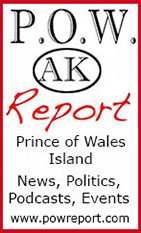

|
![]() Contact
Contact ![]()
![]() Webmail
Letters
Webmail
Letters![]()
![]() News Tips
News Tips![]()
![]() Copyright Info
Copyright Info![]() Archives
Archives![]() Alaska
Alaska![]() Ketchikan
Ketchikan![]() SE Alaska
SE Alaska![]() Dave Kiffer
Dave Kiffer![]() Money Matters
Money Matters ![]() June Allen
June Allen![]() Dave
Kiffer
Dave
Kiffer![]() Louise
B. Harrington
Louise
B. Harrington ![]() Ketchikan Links
Ketchikan Links![]() FAA Accident Reports
FAA Accident Reports ![]() NTSB
Accident Reports
NTSB
Accident Reports![]() Court Calendar
Court Calendar![]() Recent Filings & Case Dispositions
Recent Filings & Case Dispositions ![]() Court Records Search
Court Records Search![]() Sex Offender Reg.
Sex Offender Reg.![]() Public Notices
Public Notices![]() Alaska Recall Alerts
Alaska Recall Alerts![]() Recalls.gov
Recalls.gov![]() AST Daily Dispatch
AST Daily Dispatch![]() KTN
Police Reports
KTN
Police Reports![]() Juneau Police Reports
Juneau Police Reports ![]() Today's
Forecast
Today's
Forecast![]() KTN
Weather Data
KTN
Weather Data![]() AK
Weather Map
AK
Weather Map![]() AK Weathercams
AK Weathercams![]() AK Earthquakes
AK Earthquakes






